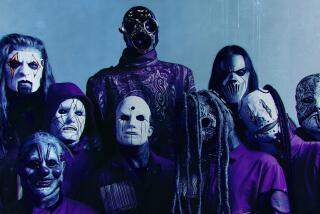POP MUSIC REVIEW : Revue Showcases Spectrum of Grindcore Rock
- Share via
When grindcore records popped up a few years ago in the darker reaches of the import-metal bins, the genre was seen as rock ‘n’ roll pushed to its logical conclusion: 15-second bursts of sound, “songs,” that sounded like nothing more than illegible death howls underpinned with throbbing white-noise. Grindcore was more or less the cultural equivalent of that tiny blip of blue light that lingers at the center of the screen after you flick off an old TV.
But as with every apocalyptic youth movement from Bill Haley on, grindcore quickly found a marketing niche: as a sophisticated new taste for Slayer fans. And although the grindcore revue at the Palladium on Friday was as satisfying as any big-hall rock ‘n’ roll event in recent years, among longtime grindcore fans there was a wistfulness for what the genre might have become.
Brutal Truth, a New York band led by former Anthrax/Nuclear Assault guitarist Dan Lilker, opened up with a set of slick, professional grindcore--if words like slick and professional can be used to describe something that still sounds like a refrigerator tumbling downstairs.
Carcass, a quartet of lovable moptop Liverpudlians, got rid of its gross-out dissection-manual slide show and most of its dissonance and came across as the most conservative band of the night--grindcore come full circle to full, modal Sabbathisms. Headliners Napalm Death, the founders of grindcore and still one of the best live bands in rock, played a strong and powerful set, mostly of newer material, that sounded like the soundtrack to Purgatory, the music of the great, gray void.
But Cathedral, regarded as the most extreme band of the moment, rocked hardest. Cathedral played as slowly as it’s possible for a rock ‘n’ roll band to play, so slowly that there was never any semblance of a back-beat, sometimes so slow that the pit, that great, ever-rotating doughnut of humanity that dominates the floor at these shows, sputtered to a stop, unable to find the beat, lost as a college violinist trying to sight-read a Bruckner adagio. It’s nice to know that there is still at least one extreme to conquer.
More to Read
The biggest entertainment stories
Get our big stories about Hollywood, film, television, music, arts, culture and more right in your inbox as soon as they publish.
You may occasionally receive promotional content from the Los Angeles Times.








